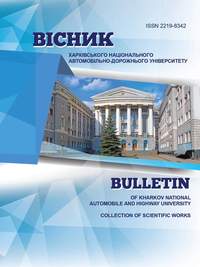The method of optimizing the main technical parameters of the promising city electric buses of ONC Type
DOI:
https://doi.org/10.30977/VEIT.2021.20.0.01Keywords:
first class electric bus, city electric bus, passenger capacity of the electric bus, parameters of electric bus masses, parameter optimization, autonomous mileageAbstract
Problem. City electric buses of the ONC type, which are widely used for passenger transportation on city routes, even if the permissible gross weight is increased by 1500 kg, have significantly lower passenger capacity than the high-class buses on the basis of the bodies of which they are created. This is due to the fact that the mass of traction batteries is much greater than the mass of the power unit with all its city bus systems. Goal. The goal is determining the optimal values of the main technical parameters of promising electric buses already at the stages of development of sketch proposals or sketch projects. Methodology. The work is based on the analysis of technical parameters of city electric buses of modern designs and regulated technical requirements for high-capacity passenger wheeled vehicles, the dependences of their passenger capacity on the dimensional parameters of the body, the weight of the equipped electric bus without the weight of traction batteries and the autonomous mileage of electric buses. Results. Three variants of a technique of optimizing the parameters of the designed city electric buses on one of the set parameters – the nominal passenger capacity, average daily autonomous run or length of a body of an electric bus are developed. Originality. An algorithm for determining the optimized parameters of the designed electric buses at the stage of development of sketch proposals and sketch projects is proposed. Practical value. The proposed method provides the design of promising competitive city electric buses of ONC type, which are most suitable for use in the cities of Ukraine, with a given or maximum possible nominal passenger capacity in terms of providing a given or maximum autonomous mileage and equality of passenger capacity, determined by passenger area mass.
References
Borén, S. (2019). Electric buses’ sustainability effects, noise, energy use, and costs. 956-971. https://doi.org/10.1080/15568318.2019.1666324.
Lajunen, A., Kivekaes, K., Baldi, F., Vepsae-laeinen, J. & Tammi, K. (2018). Different Approaches to Improve Energy Consumption of Battery Electric Buses. IEEE Vehicle Power and Propulsion Conference (VPPC). 1-6. https://doi. org/10.1109/VPPC.2018.8605024.
Hnatov A., Arhun, Shch., Ponikarovska, S. Energy saving technologies for urban bus transport. International Journal of Automotive and Mechanical Engineering. №14(4). 4649-4664. https://doi.org/10.15282/ijame.14.4.2017.5.0366.
Mohamed, M., Garnett, R. Ferguson, M. & Kanaroglou, P. (2016). Electric Buses: A Review of Alternative Powertrains. Renewable and Sustainable Energy Reviews. 62. https://doi.org/10.1016/j.rser.2016.05.019.
Houbbadi, A., Trigui, R., Pelissier, S., Redondo-Iglesias, E. & Bouton, T. (2019). Optimal Scheduling to Manage an Electric Bus Fleet Overnight Charging. Energies. https://doi.org/10.3390/en12142727.
Houbbadi, A., Trigui R., Pelissier S., Bouton T. & Eduardo R.-I. (2017). Multi-Objective Optimisation of the Management of Electric Bus Fleet Charging. https://doi.org/10.1109/VPPC.2017.8331015.
Wang, J., Kang, L. & Yongzhong, L. (2020). Optimal scheduling for electric bus fleets based on dynamic programming approach by considering battery capacity fade. Renewable and Sustainable Energy Reviews. https://doi.org/10.1016/j.rser.2020.109978.
Torabi, S., Bellone M. & Wahde M. (2020). Energy minimization for an electric bus using a genetic algorithm. https://doi.org/10.1186/s12544-019-0393-1.
Hatem, A. & Moataz M. (2021). A Prediction Model for Battery Electric Bus Energy Consumption in Transit. Energies, 14(10), 2824. https://doi. org/10.3390/en14102824.
Kivekäs, K., Lajunen, A., Baldi, F., Vepsäläinen, J. & Tammi, K. (2019). Reducing the Energy Consumption of Electric Buses With Design Choices and Predictive Driving. IEEE Tran-sactions on Vehicular Technology. 11409-11419. https://doi.org/10.1109/TVT.2019.2936772.
Єдині технічні приписи щодо офіційного затвердження транспортних засобів категорій М2 та М3 стосовно їхньої загальної конструкції : Правила ЕЭК ООН № 107-02. [Чинний з 01.07.2009]. ООН, 2011. Yedyni tekhnichni prypysy shchodo ofitsiinoho zatverdzhennia transportnykh zasobiv katehorii M2 ta M3 stosovno yikhnoi zahalnoi konstruktsii [Uniform provisions concerning the approval of category M2 and M3 vehicles with regard to their general construction]. (2011). Regulation No. 107-02 from 1st July 2009. Kyiv: Derzhstandart Ukrainy [in Ukrainian].
Войтків С. В. (2019). Напрямки створення конкурентоспроможних міських електробусів великого класу. Збірник наукових матеріалів міжнародної науково-практичної інтернет-конференції "Інноваційні технології розвитку та ефективності функціонування автомобіль-ного транспорту". Кропивницький : ЦНТУ, 13–24. Voitkiv S. V. (2019). Napriamky stvorennia konkurentospromozhnykh miskykh elektrobusiv velykoho klasu. Zbirnyk naukovykh materialiv mizhnarodnoi naukovo-praktychnoi internet-konferentsii "Innovatsiini tekhnolohii rozvytku ta efektyvnosti funktsionuvannia avtomobilnoho transportu". [Directions of creation of competitive city electric buses of a large class. Collection of scientific materials of the international scientific-practical Internet conference "Innovative technologies of development and efficiency of functioning of motor transport"]. CNTU, 13–24. [in Ukrainian].
Downloads
Published
How to Cite
Issue
Section
License
Copyright (c) 2021 Voytkiv Staniskav

This work is licensed under a Creative Commons Attribution 4.0 International License.
Автори, які публікуються у цьому журналі, погоджуються з наступними умовами:
1. Автори залишають за собою право на авторство своєї роботи та передають журналу право першої публікації цієї роботи на умовах ліцензії Creative Commons Attribution License, котра дозволяє іншим особам вільно розповсюджувати опубліковану роботу з обов'язковим посиланням на авторів оригінальної роботи та першу публікацію роботи у цьому журналі.
2. Автори мають право укладати самостійні додаткові угоди щодо неексклюзивного розповсюдження роботи у тому вигляді, в якому вона була опублікована цим журналом (наприклад, розміщувати роботу в електронному сховищі установи або публікувати у складі монографії), за умови збереження посилання на першу публікацію роботи у цьому журналі.
3. Політика журналу дозволяє і заохочує розміщення авторами в мережі Інтернет (наприклад, у сховищах установ або на особистих веб-сайтах) рукопису роботи, як до подання цього рукопису до редакції, так і під час його редакційного опрацювання, оскільки це сприяє виникненню продуктивної наукової дискусії та позитивно позначається на оперативності та динаміці цитування опублікованої роботи.








